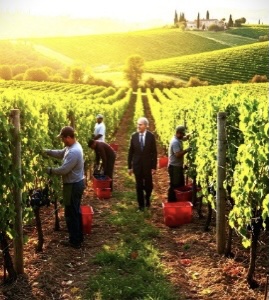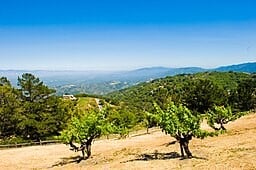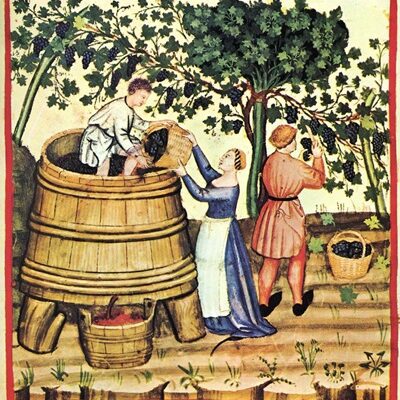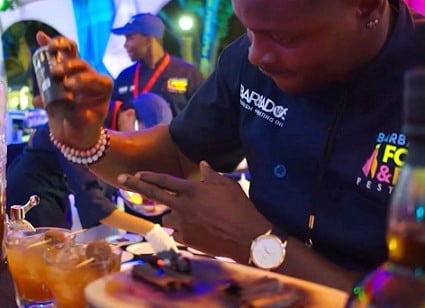The moment I saw Ian D’Agata’s name attached to the event, I knew I knew the wines selected would be extraordinary. D’Agata’s reputation precedes him as he is a noted authority in the world of wine, admired not just for his deep knowledge but for the passion and precision he brings to every glass, every lecture, every page he writes.
What makes D’Agata truly fascinating is that he didn’t set out to be a wine expert. His story begins in medicine, specializing in pediatric gastroenterology and nutrition. It was a world of research labs and clinical studies, a far cry from the vineyards of Barolo or the cellars of Sicily. Yet, even as he studied the human body, his mind was drawn to the biology of the vine.
During his medical studies, he secured two research grants in cellular and molecular biology, spending nearly three years immersed in the microscopic world of DNA and genetics. That scientific rigor would later become the backbone of his work in ampelography—the study of grapevine identification and classification. While some wine writers lean on poetry and romance, D’Agata brings data, genetics, and hard science into the conversation.
This meticulous approach defines his books, Native Wine Grapes of Italy and Italy’s Native Wine Grape Terroirs. These aren’t just lists of obscure varieties; they are deep dives into how grape genetics, history, and terroir intertwine. He doesn’t just tell us that Nerello Mascalese thrives on Etna’s volcanic slopes—he shows us why, with the precision of a scientist and the storytelling of a historian. His dedication to preserving indigenous grape varieties extends beyond Italy, as he collaborates with producers in France, Canada, and China to highlight and protect lesser-known native varietals.
D’Agata’s influence extends far beyond the written word. As the Scientific Director of Vinitaly International Academy, he has shaped how Italian wine is taught and understood globally, elevating the conversation on native grapes and terroir-driven winemaking. His masterclasses are legendary for their depth, seamlessly blending technical analysis with cultural and historical context.
Since December 2019, D’Agata has also been the Chief Scientific Officer at TasteSpirit, a leading wine and food media company in China. His role there is more than just educational—he is actively shaping China’s wine identity, spearheading projects like a terroir-based wine school and serving as Editor-in-Chief of a digital wine review. As China’s wine culture continues to evolve, D’Agata’s expertise ensures that science, tradition, and education play a central role in its growth.
Beyond his academic and literary achievements, D’Agata’s multilingual fluency in Italian, English, and French has allowed him to bridge cultures, engaging deeply with wine traditions across Europe, North America, and Asia. Whether through writing, teaching, or research, his mission remains clear: to bring clarity, depth, and scientific precision to the ever-evolving story of wine.
InMyPersonalOpinion.Life
Indigenous Grapes and Wines. New York 2025: Curated
- 2023 Reeve Wines. Vermentino Sonoma Coast; 93 percent Vermentino, 7 percent Falanghina.
Founded in 2015 by Noah and Kelly Dorrance, Reeve Wines is a boutique winery in Healdsburg, California, dedicated to small-batch, sustainably crafted wines that showcase distinctive vineyard sites. Their 2023 Vermentino Sonoma Coast exemplifies this philosophy, blending fruit from diverse terroirs across Sonoma County, from the cool, wind-swept vineyards of Carneros to the sunlit slopes of Sonoma Mountain and Dry Creek Valley.
A 7 percent addition of Falanghina enhances the wine’s depth, contributing richness while preserving its signature crispness. Fermented and aged in concrete egg, stainless steel, and neutral barrels, the Vermentino achieves a balance of freshness and textural finesse. With 12.7% alcohol and 6.3 g/L acidity, it offers a vibrant, mineral-driven profile with citrus, saline, and herbal notes, culminating in a clean, persistent finish.
Notes
In the glass, the wine presents a pale, sunlit straw hue with hints of green, signaling its vibrancy and youthful freshness. On the nose, aromas of green melon, cucumber, and chalky limestone emerge first, followed by delicate floral notes of white blossom and citrus zest. Subtle hints of crushed seashell and fresh-cut herbs lend a distinct maritime character, reinforcing the wine’s mineral backbone.
The palate is where the interplay of acidity and texture shines. Crisp, mouthwatering notes of lemongrass, green mango, and a touch of saline minerality define the flavor profile. The Falanghina component adds a slight creaminess, offering an elegant contrast to the wine’s electric acidity and ocean-breeze freshness.
2. Massican Gemina 2023. Blend of Greco, 60 percent; Falanghina, 23 percent, Fiano, 17 percent.
Massican Winery, founded in 2009 by Dan Petroski, stands out in Napa Valley for its exclusive focus on white wines—an unconventional choice in a region known for its reds. Inspired by the fresh, mineral-driven whites of Italy’s Mediterranean regions, Petroski crafts vibrant, elegant wines that showcase California’s terroir. Sourcing from 13 sustainably or organically farmed vineyards across the North Coast, Massican emphasizes environmental responsibility. The winery further reinforces its commitment to sustainability through its participation in Napa Green, a certification program promoting eco-friendly practices in the wine industry.
In the cellar, Massican follows a minimal-intervention approach to fermentation, preserving the grapes’ natural freshness and bright character. While honoring traditional winemaking techniques, the winery integrates modern technology to enhance sustainability and efficiency. It utilizes Flextanks—innovative vessels that mimic barrel aging through controlled micro-oxygenation. These tanks streamline cellar operations by reducing water and labor costs while optimizing space, reinforcing Massican’s commitment to both quality and environmental responsibility.
In August 2023, Massican entered a partnership with E. & J. Gallo’s Luxury Wine Group. This collaboration aims to expand Massican’s reach
Notes
The Massican Gemina 2023 presents as a white gold-colored wine in the glass and opens with aromas of Anjou pear, almond, and beeswax, complemented by hints of fennel and faint pineapple. On the palate, it introduces flavors of lime and white peach, intermingled with fresh herbs, orange zest, and a mineral undertone, culminating in a mouthwatering, dry finish creating a wine that seamlessly marries Italian tradition with Californian terroir
3. Masottina R.D.O Levante Conegliano Valdobbiadene Prosecco Superior DOCG Rive Di Ogliano Extra dry 2023. Glera, 100 percent
Founded in 1946 by Epifanio Dal Bianco, Masottina has deep roots in Italy’s Conegliano Valdobbiadene region. Under the leadership of his son Adriano and grandsons Federico and Filippo, the winery has grown to nearly 220 hectares, championing the quality of Conegliano Valdobbiadene Prosecco Superiore DOCG, particularly the Rive di Ogliano. The R.D.O stands for Rive di Ogliano, a specific cru or vineyard within the Conegliano Valdobbiadene, Prosecco Superiore DOCG area. The term Rive denotes the steep hillside vineyards in this region, each with its unique terroir that adds distinct character to the wine.
Masottina’s R.D.O. Levante is crafted from hand-harvested grapes from 60-year-old, east-facing vines, benefiting from constant breezes that shape its character. Using gravity-fed vinification for gentle grape handling, the wine undergoes secondary fermentation and maturation over 120 days in steel tanks, followed by a month of bottle aging. The result is a refined Prosecco Superiore with 13 g/l of residual sugar and 11.5% alcohol, embodying the elegance of its terroir.
Notes
In the glass it presents a bright, straw-yellow color with fine, persistent bubbles while the nose is greeted with fresh and fruity notes, including hints of green apple, lemon zest, and white flowers. There are also subtle mineral undertones that reflect the terroir of the Rive di Ogliano vineyard. On the palate, it is light and refreshing, with flavors of orchard fruits like pear and apple. The wine has a balanced sweetness due to its extra-dry style, complemented by a crisp acidity and a soft, creamy perlage. The finish is clean and slightly mineral, leaving a pleasant aftertaste.
4. Agricola Marrone Barolo Bussia DOCG 0.75 1 2017. Nebbiolo, 100 percent, specially the Lampia and Michet biotypes that are known for their ability to produces wines with exceptional structure, complexity and aging potential. The grapes are sourced from the esteemed Bussia vineyard, known for its optimal Nebbiolo-growing conditions.
The notation 0.75 1 2017 in the context of Agricola Marrone Barolo Bussia DOCG refers to:
0.75: The bottle size, which is 0.75 liters (standard wine bottle size).
1: Likely indicates a single bottle (as opposed to a case or multiple bottles).
2017: The vintage year the wine was produced from grapes harvested in 2017.
Agricola Gian Piero Marrone is a family-owned winery located in La Morra within Italy’s renowned Langhe region. The family has been producing wines for over a century and date back to 1910 when Pietro Marrone, at the age of 23, sought his father’s permission to implement innovative vineyard practices aimed at enhancing grape quality. This pioneering spirit has been passed down through four generations, with the winery currently managed by Pietro’s great-granddaughters: Valentina, Serena, and Denise, alongside Serena’s husband, Marco.
Notes
In the glass the wine presents a deep ruby red color with garnet reflections. The nose is intense and layered, offering notes of violets, cherries, berries, menthol, licorice, and leather. On the palate, it is full-bodied yet refined, with flavors of red fruits, savory herbs, and subtle oak nuances. The wine is well-structured, with fine-grained tannins and a long, persistent finish.
The wine undergoes fermentation with skins and maceration at 30°C for 25 days in stainless steel tanks. Malolactic fermentation takes place in large oak barrels, followed by 30 months of aging in wood. The initial 10 months involve batonnage on fine lees, enhancing its texture and complexity. Before release, the wine is bottle-aged for at least six months in a temperature-controlled environment.
5. Bocale Montefalco Sagrantino DOCG 2019. Single-varietal wine made exclusively from the Sagrantino grape which is native to the Montefalco region in Umbria, Italy, celebrated for its bold character, intense color, and high tannin content.
The Bocale winery, located in Montefalco, Umbria, Italy, is deeply rooted in tradition and passion for winemaking. The name Bocale refers to an ancient term for a two-liter jug of wine, symbolizing the winery’s connection to its cultural heritage. Bocale is committed to sustainability and quality.
Notes
In the glass, it displays a deep, rich garnet-red color with purple reflections. On the nose, it offers a complex bouquet of dark berries like blackberry and blackcurrant, intertwined with hints of spices such as clove, cinnamon, and anise. Earthy undertones of leather and a touch of dried herbs enhance its aromatic depth. The wine is full-bodied and intense, showcasing ripe black fruits balanced by vibrant acidity. Notes of sage and roasted earth emerge alongside a slight touch of cocoa. Its structured tannins provide a robust backbone, leading to a long and polished finish.





